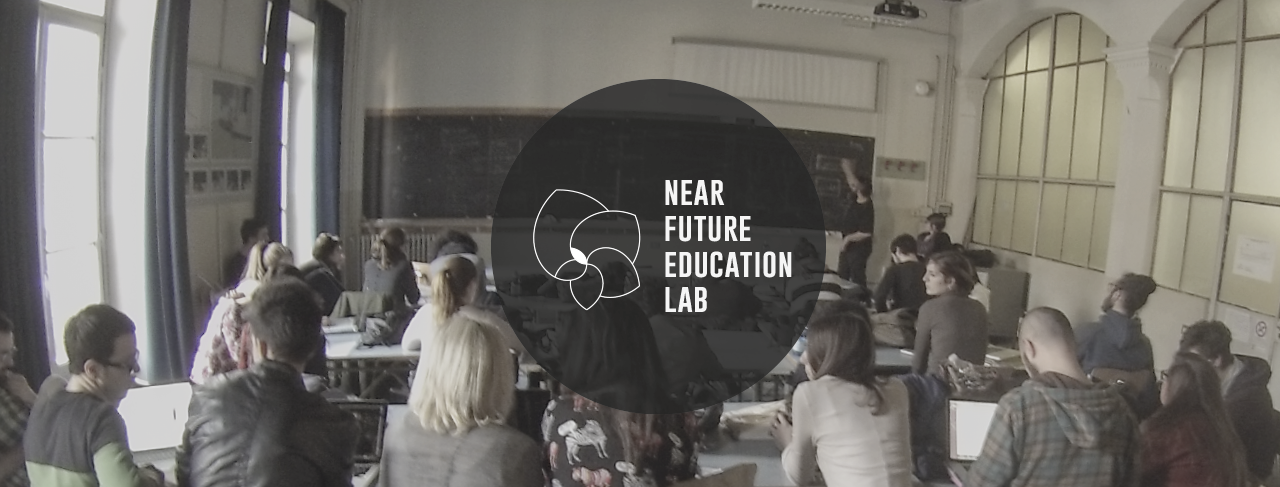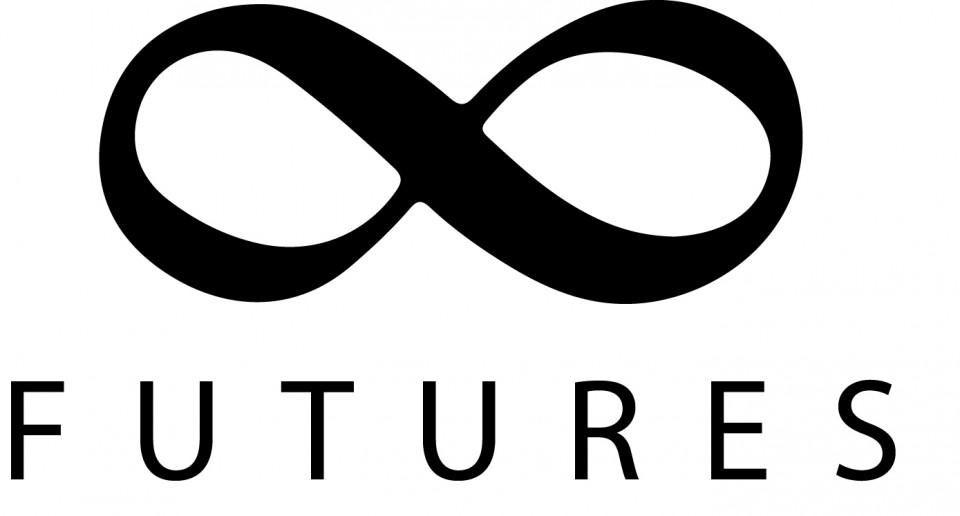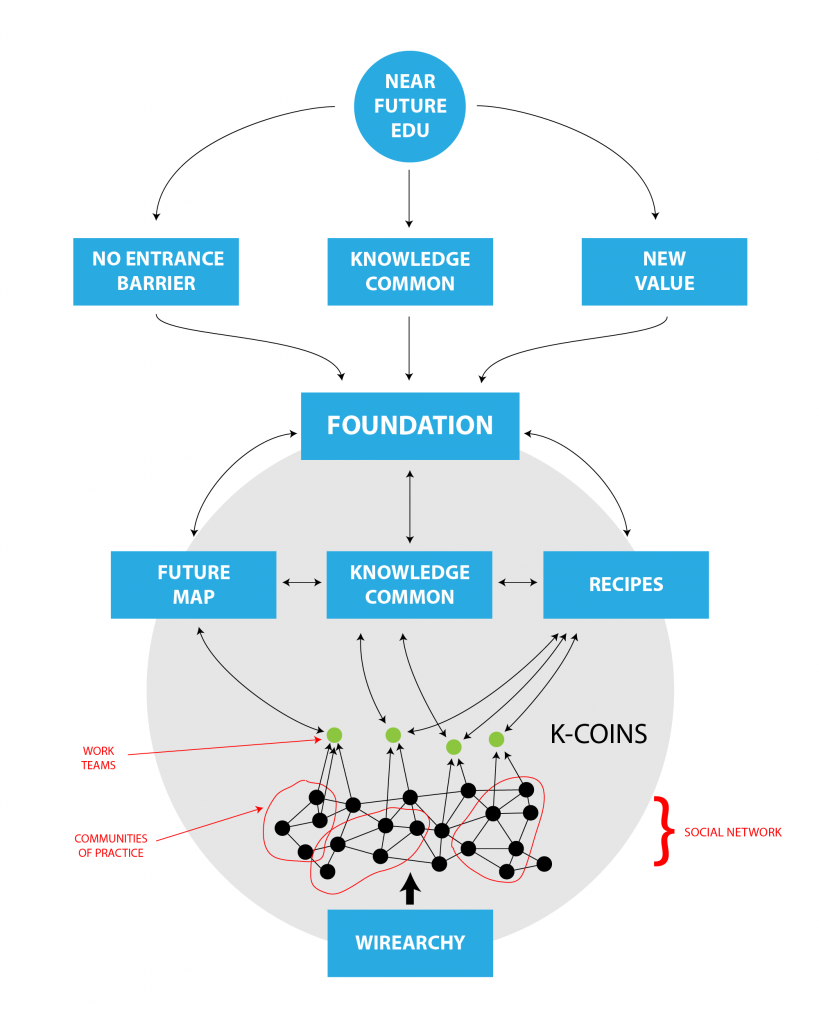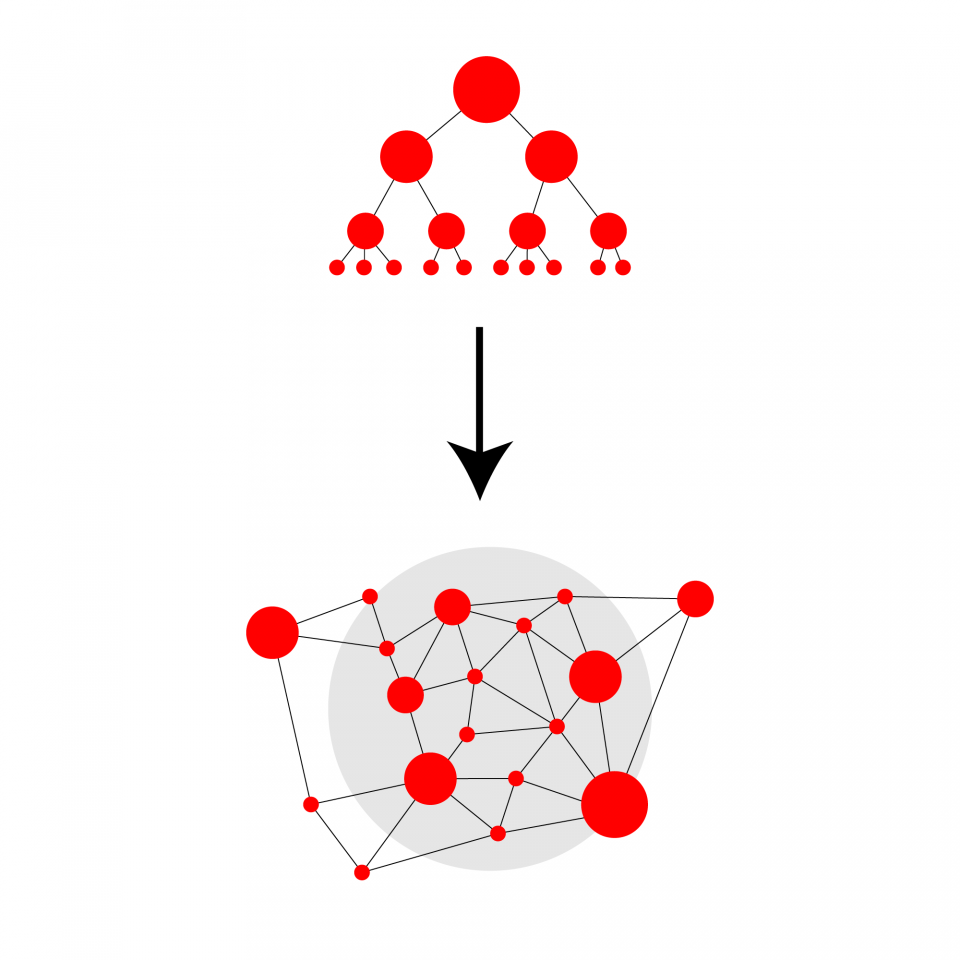Introduction
With students, designing the future of the education system. A fundamental action towards a shift to a participatory, inclusive knowledge society. This post describes the structure and methodology of our action.
- Follow what is happening using the blog dedicated to the project: http://nearfutureducationlab.nova100.ilsole24ore.com/
- You can also join the Near Future Education Lab on its Facebook Group and follow the project on Twitter.
- Constant updates are maintained on the P2P Foundation Wiki, Near Education Lab
Note: This post is the result of the conversation which we had at CyberResistance in Milan, at the Cantiere.
The Future does not Exist.
In our approach to Near Future Design we try to create a state of suspension in which it is possible to explore multiple versions of future scenarios and to engage people from different cultures and backgrounds to enable them to become performers, able to express themselves in highlighting not just (technically/technologically) possible futures, but desirable, preferable futures.
There are a few steps involved in doing this.
The first step is to create a Future Map.
From our point of view, the building a Future Map involves the combination of a technical/technological activity together with an ethnographical/anthropological one.
The first one involves the comprehension of the current State of the Arts & Technologies: current technological advances, promising research, patents, new products, trends, etcetera. Given proper and reliable information sources, this task is rather simple, in that it requires to keep updated.
The second one is fairly more complex, as it requires the comprehension of the Established Narratives, the Strange Now and the Future Possibilities.
The Established Narratives describe our common understanding of consensual reality. Given a certain topic or domain, the established narratives enclose the forms of consensus which is accepted within relevant communities or cultures: “normal” things within the domain, as they are culturally, traditionally and commonly understood.
The Strange Now describes the emergence of recurring patterns, rituals and other behaviours. Although having become recurrent, these behaviours do not yet benefit from widespread social understanding, comprehension and encoding: they are commonly understood as “strange”, peculiar or curious.
The Future Possibilities describe what people in relevant cultures and communities perceive as possible, feasible and technically/technologically advanced and desirable regardless of their actual technological feasibility, present or future: they describe people’s perception of possibility, in the future.
All these elements are combined into a Design for the New Normal. Its objective is to merge the two types of results into the description of near future designs: the “things” which will be normal a short time from now; the next normality field.
The Near Future Design is represented in a series of ways and it becomes a Simulacrum: a state of suspension of disbelief in which the Design is implemented using a Transmedia Narrative whose objective is to make it as believable and likely as possible, so much that it becomes so entangled in consensual reality that it eventually becomes it.
In particular, this last phase, happens by means of imagination, performance and desire. It is a language-based operation, in which a linguistic landscape is created which allows for the emergence of new imaginaries: people become performers by apprehending new languages, which allow them to imagine new things and concepts and, in turn, to bring them to life, through desire. The performance of the future: people’s perception of what is possible shifts, as they experience a transmedia simulacrum which is so likely that they start using it, eventually making it become true and, in the process, express themselves on what is their desired, preferred future.
This is exactly what we are doing with the education system.
The Near Future of the Education System.
Together with the students at ISIA Design in Florence we are using Near Future Design techniques to design the Near Future of the education system. To do this, we are following the the full Near Future Design methodology outlined above, and we are enacting the transmedia simulacrum in two ways: by enacting a transmedia narrative which will be started shortly, in the following phases of the action, and by adopting the model we’re designing, performing it and using it ourselves, to experiment it on the field according to an agile methodology, by designing it, implementing it, releasing/using it in its beta version, and by redesigning it according to a series of iterations, forks, merges.
Here below is an image which describes the structure of our initial design, further detailed in the next sections.
Assumptions
Assumption number 1: decent education has an really high entrance/access barrier.
If you have a lot of money, you don’t have a problem with the current education system. If you can afford the hundreds of thousands of dollars which are needed to attend the best (and not-so-best) schools in the world, you really do not feel the crisis. You have laboratories, personalised courses, a good student/professor ratio, tutoring, mentorship, auditoriums, libraries, equipment, etcetera, you have it all.
Too bad that not many people have all of this money. And even of the ones that do, most of them rely on Debt to obtain access to these schools, and debt – as we have learned – comes with an awful lot of implications.
Assumption number 2: current education models are mostly competitive rather than collaborative.
Competitive models may be adequate for the industrial era, but they are not for the networked, information/knowledge/communication era, which is based on collaboration, universal access and inclusion. All of which are critical to the creation of social capital and the ushering in of a sharing economy.
Assumption number 3: knowledge as a common.
Not only because, as Rifkin puts it, it allows for marginal costs to tend relentlessly towards zero, with all that this implies, but also (and most of all) because, as Bauwens frames it, in the framework defined by Contributory Commons (provided by the Civil Society) and Ethical/Solidary Economy (the Reframed Corporation), an Information & Knowledge Common is enabling and empowering, and should be defended as a strategic asset.
Assumption number 4: perceptive, cognitive, attention and strategic models for education.
The ways in which we learn, collaborate, work, design and relate have radically changed. From a perceptive and cognitive point of view, and from the perspective which sees the emergence of novel modalities in which multiple disciplines converge, different roles become entangled, serendipitous actions become strategic and, in the passage from atoms to bits and back, the production of knowledge and information becomes a performance which is cultural and linguistic, and which is polyphonic, interconnected, emergent in nature.
Assumption number 5: need for a new definition of “value”.
From the P2PValue project page:
Commons-based peer production (CBPP) is a new and increasingly significant model of social innovation based on collaborative production by citizens through the Internet.
In this framework a novel definition of “value” must be found, encompassing the well-being of the ecosystem, and in a mutualistic sense, progressively loosing the definition of “value” determined by the market sale price of products and services, and embracing one which is mutually determined, at a peer-to-peer level.
On top of these 5 initial assumptions, the State of the Arts & Technologies and the Strange Now analyses have provided indications about 11 axes in which we have dimensioned our proposed design. You can read more about the 11 axes of transformation on the NearFuture Education Lab’s blog on Nòva24.
The Foundation
Why create a Foundation to explore the Near Future of Education?
There are multiple answers. Two are the most important ones: to enact a strategic shift, and to host, protect and preserve the Knowledge Common that is at the center of ecosystem.
First: to enact a strategic shift.
In the current situation, a hierarchical organisation of things and processes is in place: governments and companies deal with each other to establish policies and strategies which are applied to, in this case, schools and universities and, by them, to students and other participants. This has major political, social and economic implications. And, maybe most important of all, is not flexible, resilient and capable of adapting to the transformation of cultures, societies and the environment, or to take into account people’s and communities’ desires, visions, expectations and emergent behaviours.
The transformation we propose is dedicated to creating an environment, a space.
The environment is the Knowledge Common, which is protected and preserved by the Foundation.
The Foundation itself is open, accessible and permeable: anyone can get in, but it is not necessary to get in to make use of the Knowledge Common.
Multiple forms of interaction and interrelation with this environment are possible, such as contributing to the Common, using the knowledge contained there within, producing recipes to it, a particular form of meta-knowledge (and, thus, that is part of the ecosystem itself) which shows how the various parts of the Common can be used together, combined, assembled together with other relations, elements, or even with other recipes.
These forms of interaction can come from inside/outside/edge of the environment/common.
The Foundation, open and accessible to everyone, preserves the Common.
The Currency
The Knowledge Common has a value, which constantly grows.
This value is measured using K-Coins, Knowledge Coins.
K-Coins are a mutualistic currency, which is used to measure how much a person or organisation contributes to the value (well-being) of the Environment/Common.
K-Coins are mutually assigned: if subject A perceives that subject B contributes to the value of the ecosystem (by participation, contribution, production, meta-production…), A can assign K-Coins to B. In other words, K-Coins are proportional to the Reputation which one has in relation to their active participation to the well-being of the Environment/Common.
(some additional info on the ways in which we are designing the K-Coins may be found here: http://p2pfoundation.net/Near_Future_Education_Lab )
Agile Ecosystem: pull, fork, watch, merge
All the things we have seen so far (and the next to come) represent knowledge, as well.
The Future Map, the definition of the Foundation (its statute and regulations, for example), the K-Coins definition and the software needed to make them work, the collaboration and relation tools… everything that we describe here is part of the Knowledge Common that constitutes the core of the Environment, of the Public Space, that we are describing.
As such, they can be freely accessed and used.
Using the Git metaphor, they can be watched (to know how they’re changing), pulled (to use them), forked (to modify them, creating your own version) and merged (to take the results of multiple contributions and to assemble them into a new version).
If a certain subject grabs and modifies, let’s say, the Future Map, or the statute of the Foundation, they can use it for their own purposes, but the results remain part of the Knowledge Common, together with their relation with the original version.
This fact has enormous cultural, political and practical implications.
First of all determined by the possible co-existence of multiple versions of everything.
This implies, for example, that if I have a certain vision of the Future Map, of how the future of the education system could be, I could just fork the currently adopted Future Map, modify in ways which reflect my point of view, and put it back up for merging. Then other people will be able to make their own decisions: merge it, fork it on their own and use it, or else. In any case, I would be able to use my own Future Map for my own purposes (in this case, to aim at a certain objective in the transformation of the future of the education system).
In all this, K-Coins allow everyone to express (currency as a means of expression) themselves about their perception of my contribution to the Common, contributing to my reputation and, thus, augmenting the value of the environment/common itself.
This possibility for measure also achieves a virtuous effect: since everyone’s reputation is connected to their active contribution to the well-being of the Knowledge Common that constitutes the environment, and since the K-Coins measuring it are mutually assigned, everyone will be engaged into making positive contributions, thus augmenting their value, thus incrementing their reputation and possibilities/opportunities within the ecosystem.
How Does all this Work?
The Foundation will work as a Wirearchy.
In Wirearchy a social network (in our case it will be a combination of a peer-to-peer social network, and of a meta-social network, operating in piggy-back with major social networks such as Facebook and Twitter and in mode physical modalities) hosts conversations, relations and interaction.
From these, the communities of practice emerge: people and organisations interested and involved in certain topics, domains and issues, and making experiments, hypotheses, researches…
Work teams can emerge from all this, eventually including some or all members of the communities of practice as well as participants from the rest of the social network, or even from beyond its (fuzzy) boundaries. Work teams actively work on the domain/theme/issue, eventually arriving at the definition/creation/implementation/deployment of a certain information, knowledge, object, product, service or else.
In this ecosystem, any form of production includes two elements: knowledge and other things (such as objects, products, services…).
All knowledge produced becomes part of the Knowledge Common.
All the rest may be sold, offered, used or else, at the discretion of the producers.
The knowledge produced and put back into the Common defines the “value” of the “project” within the ecosystem, through the number of K-Coins that other people assign to it – from their point of view and if they desire to do so – evaluating how it contributes to the well-being of the ecosystem.
Recipes
Within the ecosystems, a series of subjects produce recipes.
Each project, course, study program, how-to, tutorial… each of these things is a recipe, may contain and use recipes and may be contained in one or more recipes.
Recipes are like the ones for cooking: they contain ingredients, and the instructions on how to combine them to obtain a certain result.
Recipes, as forms of (meta-)knowledge are part of the Knowledge Common.
There can be recipes about what is the education path to become a Designer, an Engineer, a Cultural Anthropologist. Recipes about how to build chairs, drones, particle accelerators. Even recipes about cooking.
A certain recipe may indicate that, before attempting to do something, I should learn something: Recipe to create object X could state that “you can use software tools Y and Z, physical tools K and T, and you have to follow course A, preferably with Mr. B, and it would be better to join Lab C, and you would need the collaboration of at least 1 person who has followed course D and E, and who is proficient in using tool Y”.
Recipes can be produced by multiple subjects: I, for example could produce a recipe about “what you need to learn and do to become a proficient Communication Designer”.
Other people could create similar recipes (starting from scratch, or forking my recipe, for example): other designers, people who think they know what it takes to become a Communication Designer, and more.
One peculiar type of subject which could desire to have its say about this could be, for example, the Italian Ministry for University and Research (the MIUR), or any other governmental institution in other parts of the world. Actually, all of these types of subjects basically occupy their time creating “recipes” – under the form of official study plans, policies, regulations and more. We recognise these plans, rules and regulations as valid and mandatory on the premise that we trust these governmental entities and institutions, and that we acknowledge them the role of the maintainers of the systems in which sciences, humanities and research can thrive and prosper.
It’s a matter of trust, and reputation.
What could, then, happen in the ecosystem which we’re describing?
It may become true that Mr. X’s recipe on “how to become a Robotic Engineer” is valued more (in K-Coins) than the one from the MIUR, other Government Agencies, or even than the one from Stanford, or even MIT. Because…? It can happen for multiple reasons, of course. One of them is that, in the ecosystem, more people have recognised more value (by attributing K-Coins) to Mr. X’s recipe. This would mean that the education ecosystem recognises Mr. X’s recipe more valuable than the one by the Ministry, or by Stanford, or by…
This possibility is disruptive: what could a Ministry of Education, or Stanford, or MIT do in this case? They could produce a better recipe, or adopt Mr. X’s, or fork it or… many more things. Sure is that that they would have to act, in order to bring more well-being to the ecosystem.
Let’s look at some scenarios.
How can I teach in this Ecosystem?
I could offer a course/lab/training-on-the-job/something using the social network, or by participating to a Community of Practice or Work Team (and possibly recognising the need for such an offering), or because I really enjoy teaching a certain subject/practice, or because I have the tools/spaces/conditions to offer it, or else.
In my offering I can use elements from the Knowledge Common, optionally forking them and creating my own versions, which are put back into the Common. I can use recipes, and produce recipes of my own, to be used in the course or outside of it (“my course is needed to learn how to build object X, as described by recipe Y”). The offering can also be included in recipes by other subjects, which deem it as being fundamental for achieving a certain purpose.
These same people may decide to replace a certain element of their recipe with my offering, should they be convinced (and, in this, reputation helps) that mine is better.
Eventually, I will give the course/lab/stage/practice… and the people who have participated (students, recipe-adopters, be that to become an engineer, complete a project, to learn something so that I can then teach it, to learn something for no purpose at all…) may decide to assign me some K-Coins for my positive and active participation to the well-being of the Ecosystem.
From this moment my offering would benefit from increased reputation.
How can I create a project in the Ecosystem?
This scenario works much in the same way like the previous one.
The major difference is in its augmented degree of generality.
To engage a project you have to learn something, use knowledge and information, assemble a certain number of recipes, and more. All to produce, as described, more knowledge and some objects/products/services/other.
Thus, it would work out in the same way.
The social network/communities of practice/work teams scheme could be used to start a project. The project would use elements from the Knowledge Common (be them single elements or recipes…), combining them with courses, laboratories and relations with other people and organisations which would have to have access to knowledge and recipes (either directly or by “going to school”) and, possibly, a certain level of reputation.
In this scenario: the value of reputation in the ecosystem becomes self-evident, as enabler, facilitator, multiplier, accelerator of the action.
How can I learn something in the ecosystem?
You always learn in this ecosystem.
One of the strengths of this approach is the explicitation of this fact: in different moments and contexts of their life subjects will act as “learners”, professors, laboratories, entrepreneurs, producers of recipes, and more.
I could decide to learn in multiple ways: by choosing a certain recipe (based on the reputation of its creator, or for some other reason); by choosing a certain course/lab/other offering; by joining into a project in which I would need to learn a certain thing or adopt a certain recipe.
Or I could even identify that no-one is currently offering a certain course/lab/training/other, and by using the social network/communities of practice/work teams to try to make it available (and this would also be an opportunity for someone to actually create the offering).
If all else fails, I could try to learn by myself in some way, and, maybe, even offer the course myself.
In all this, the usual mechanism applies: of all the contributions which I used (the course, lab, recipe or else) I would be able to assign K-Coins to attribute to them reputation, based on my perception of how they contributed to the well-being of the ecosystem and of the Knowledge Common.
Conclusions
We’re building all of this and, in the next few months, you will see much more happening.
As stated above: this process which we’re building is the first contribution to the Knowledge Common itself.
You all can (and should) contribute to it in any way you can: by participating, designing with us, helping us to communicate, to get in touch with people, groups, organisations, institutions who could be interested in these kinds of developments.
In four words: to make this happen.
More news really soon.
In the meanwhile follow us and join in like this:
- Follow what is happening using the blog dedicated to the project: http://nearfutureducationlab.nova100.ilsole24ore.com/
- You can join the Near Future Education Lab on its Facebook Group and follow the project on Twitter.
- Constant updates are maintained on the P2P Foundation Wiki, Near Education Lab
![[ AOS ] Art is Open Source](https://www.artisopensource.net/network/artisopensource/wp-content/uploads/2020/03/AOSLogo-01.png)



